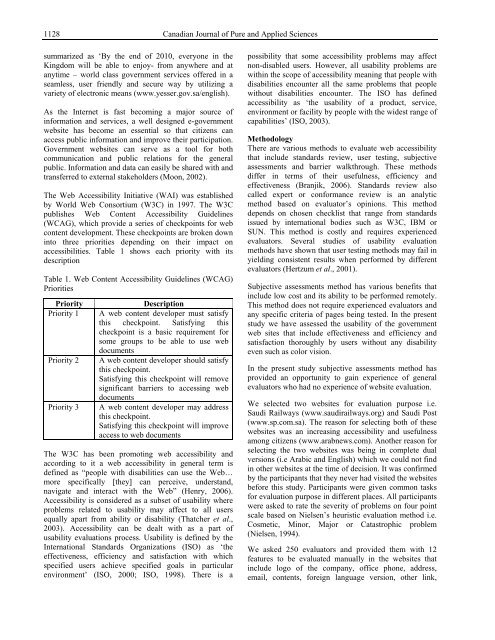Download (5Mb) - Covenant University Repository
Download (5Mb) - Covenant University Repository
Download (5Mb) - Covenant University Repository
Create successful ePaper yourself
Turn your PDF publications into a flip-book with our unique Google optimized e-Paper software.
1128<br />
summarized as ‘By the end of 2010, everyone in the<br />
Kingdom will be able to enjoy- from anywhere and at<br />
anytime – world class government services offered in a<br />
seamless, user friendly and secure way by utilizing a<br />
variety of electronic means (www.yesser.gov.sa/english).<br />
As the Internet is fast becoming a major source of<br />
information and services, a well designed e-government<br />
website has become an essential so that citizens can<br />
access public information and improve their participation.<br />
Government websites can serve as a tool for both<br />
communication and public relations for the general<br />
public. Information and data can easily be shared with and<br />
transferred to external stakeholders (Moon, 2002).<br />
The Web Accessibility Initiative (WAI) was established<br />
by World Web Consortium (W3C) in 1997. The W3C<br />
publishes Web Content Accessibility Guidelines<br />
(WCAG), which provide a series of checkpoints for web<br />
content development. These checkpoints are broken down<br />
into three priorities depending on their impact on<br />
accessibilities. Table 1 shows each priority with its<br />
description<br />
Table 1. Web Content Accessibility Guidelines (WCAG)<br />
Priorities<br />
Priority Description<br />
Priority 1 A web content developer must satisfy<br />
this checkpoint. Satisfying this<br />
checkpoint is a basic requirement for<br />
some groups to be able to use web<br />
documents<br />
Priority 2 A web content developer should satisfy<br />
this checkpoint.<br />
Satisfying this checkpoint will remove<br />
significant barriers to accessing web<br />
documents<br />
Priority 3 A web content developer may address<br />
this checkpoint.<br />
Satisfying this checkpoint will improve<br />
access to web documents<br />
The W3C has been promoting web accessibility and<br />
according to it a web accessibility in general term is<br />
defined as “people with disabilities can use the Web…<br />
more specifically [they] can perceive, understand,<br />
navigate and interact with the Web” (Henry, 2006).<br />
Accessibility is considered as a subset of usability where<br />
problems related to usability may affect to all users<br />
equally apart from ability or disability (Thatcher et al.,<br />
2003). Accessibility can be dealt with as a part of<br />
usability evaluations process. Usability is defined by the<br />
International Standards Organizations (ISO) as ‘the<br />
effectiveness, efficiency and satisfaction with which<br />
specified users achieve specified goals in particular<br />
environment’ (ISO, 2000; ISO, 1998). There is a<br />
Canadian Journal of Pure and Applied Sciences<br />
possibility that some accessibility problems may affect<br />
non-disabled users. However, all usability problems are<br />
within the scope of accessibility meaning that people with<br />
disabilities encounter all the same problems that people<br />
without disabilities encounter. The ISO has defined<br />
accessibility as ‘the usability of a product, service,<br />
environment or facility by people with the widest range of<br />
capabilities’ (ISO, 2003).<br />
Methodology<br />
There are various methods to evaluate web accessibility<br />
that include standards review, user testing, subjective<br />
assessments and barrier walkthrough. These methods<br />
differ in terms of their usefulness, efficiency and<br />
effectiveness (Branjik, 2006). Standards review also<br />
called expert or conformance review is an analytic<br />
method based on evaluator’s opinions. This method<br />
depends on chosen checklist that range from standards<br />
issued by international bodies such as W3C, IBM or<br />
SUN. This method is costly and requires experienced<br />
evaluators. Several studies of usability evaluation<br />
methods have shown that user testing methods may fail in<br />
yielding consistent results when performed by different<br />
evaluators (Hertzum et al., 2001).<br />
Subjective assessments method has various benefits that<br />
include low cost and its ability to be performed remotely.<br />
This method does not require experienced evaluators and<br />
any specific criteria of pages being tested. In the present<br />
study we have assessed the usability of the government<br />
web sites that include effectiveness and efficiency and<br />
satisfaction thoroughly by users without any disability<br />
even such as color vision.<br />
In the present study subjective assessments method has<br />
provided an opportunity to gain experience of general<br />
evaluators who had no experience of website evaluation.<br />
We selected two websites for evaluation purpose i.e.<br />
Saudi Railways (www.saudirailways.org) and Saudi Post<br />
(www.sp.com.sa). The reason for selecting both of these<br />
websites was an increasing accessibility and usefulness<br />
among citizens (www.arabnews.com). Another reason for<br />
selecting the two websites was being in complete dual<br />
versions (i.e Arabic and English) which we could not find<br />
in other websites at the time of decision. It was confirmed<br />
by the participants that they never had visited the websites<br />
before this study. Participants were given common tasks<br />
for evaluation purpose in different places. All participants<br />
were asked to rate the severity of problems on four point<br />
scale based on Nielsen’s heuristic evaluation method i.e.<br />
Cosmetic, Minor, Major or Catastrophic problem<br />
(Nielsen, 1994).<br />
We asked 250 evaluators and provided them with 12<br />
features to be evaluated manually in the websites that<br />
include logo of the company, office phone, address,<br />
email, contents, foreign language version, other link,

















